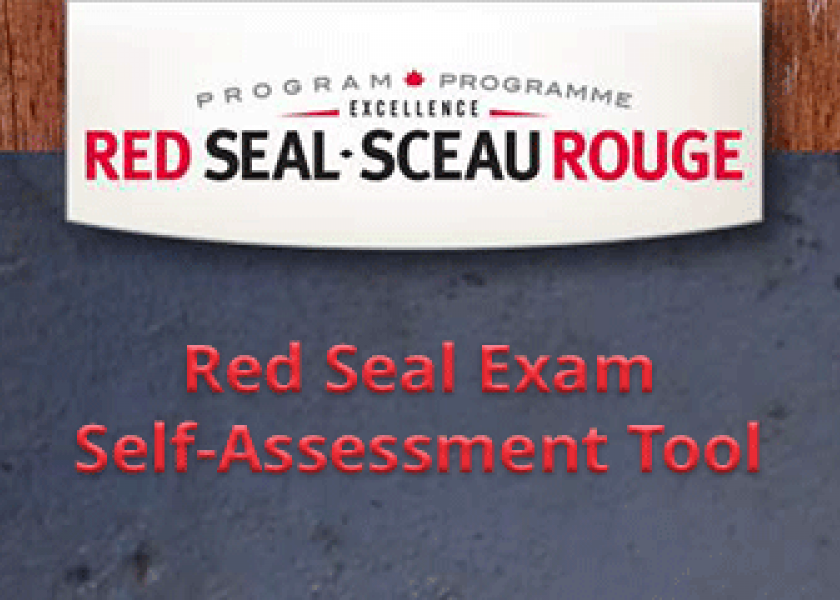Preparing for a Trades Exam
There are lots of resources available to you to help you prepare for your trades exams. Learning supports are not one-size-fits-all. You need to make a realistic assessment of what you will need to do to succeed. Make the connections with needed tutors, mentors, and peers and find the resources that will work for you. This page offers key information as well as links to available resources.
All written exams contain 100 to 150 multiple-choice questions. Exams usually take 4 hours to write. Not all the material on the certification exam is covered in the technical training sessions. Technical Training accounts for 15% of your apprenticeship journey. It is expected that you will learn 85% of your trade on the job.
The Red Seal Self-Assessment Tool & Exam Preparation Guide
The Red Seal website offers the Red Seal Self-Assessment Tool and Exam Preparation Guide. (The Exam Prep Guide may also be useful for non-Red Seal trades.)
Occupational Standards and Curriculum Standards
Exams cover the "full scope of the trade". The following formal documents are essential for preparing for exams:
- The Occupational Standard defines the full scope of the trade. The questions on level and certification exams are drawn directly from the sub-tasks detailed in this standard, which is either a National Red Seal Occupational Standard (RSOS) or a Nova Scotia Occupational Standard (NSOS/POA). The standard identifies the number/percentage of questions on the certification exam for each major work area or task. This information can also be found on the Red Seal Exam Counseling Sheets (for Red Seal Exams) and the NS Exam Counseling Sheets (for Non-Red Seal Provincial Exams and level exams). Each occupational standard also contains a list of the tools of the trade, a glossary and acronyms, which can help with the formal trade language that is used on exams, rather than slang terms.
- The Curriculum Standard divides the Occupational Standard into levels and defines the scope for each level exam. Curriculum standards are set provincially, though many are harmonized with the other Atlantic Provinces.
Practice Exams, Prep Courses and External Resources
The Nova Scotia Apprenticeship Agency neither endorses nor recommends the use of the following materials. These resources have not been vetted by the Agency, and we cannot guarantee the accuracy or authenticity of their content. They are provided solely as a guide to known available resources.
- Several trades:
- FREE sample questions: Red Seal website, click on Trades in the top menu, then click on Red Seal Trades. Select your trade from the list and click on Sample Questions.
- FOR PURCHASE: Practice exams are available for purchase at examapps.com.
- FOR PURCHASE: Practice exams are available for purchase at exambank.com.
- Automotive Service Technician:
- Centennial College Press provides the "Canadian Automotive Service Technician: Certificate of Qualification Test Preparation" book, which contains practice tests that closely imitate the Red Seal exam in both content and level of difficulty. It also provides rationale for answers.
- Black Beauty Culture Hair Innovator Practice Questions c/o Nova Scotia Apprenticeship Agency
Construction Electrician:
- Online quizzes and textbooks covering electricity and electronics are available at thelearningpit.com and https://www.allaboutcircuits.com/.
- Centennial College Press provides the "Canadian Construction and Maintenance Electrician: Certificate of Qualification Exam Preparation" book, which contains practice tests that closely imitate the Red Seal exam in both content and level of difficulty. It also provides rationale for answers.
- Canadian Electrical Practices Course (for international clients)
- CSA "Canadian Electrical Code Products" including virtual and online courses on how to use the Canadian Electrical Code; online training modules based on specific sections of the code; courses on the latest changes to the code; and courses to understand and apply the most commonly used code sections.
- Heavy Duty Equipment Technician:
- Centennial College Press provides the "Canadian Heavy Equipment Technician: Certificate of Qualification Test Preparation" book, which contains practice tests that closely imitate the Red Seal exam in both content and level of difficulty. It also provides rationale for answers.
- Industrial Electrician:
- Online quizzes and textbooks covering electricity and electronics are available at thelearningpit.com and https://www.allaboutcircuits.com/.
- CSA "Canadian Electrical Code Products" including virtual and online courses on how to use the Canadian Electrical Code; online training modules based on specific sections of the code; courses on the latest changes to the code; and courses to understand and apply the most commonly used code sections.
- Plumber:
- Plumber trade math FREE sample questions and answers: The government of Ontario and The Mid North Network have developed a guide for Preparing to Write the Certificate of Qualification Exam in Ontario, which contains a section with free sample math questions (and answers) for the Plumber trade.
- Truck and Transport Mechanic:
- Centennial College Press provides the "Canadian Truck and Transport Mechanic: Red Seal Exam Preparation" book which contains practice tests that closely imitate the Red Seal exam in content and level of difficulty. It also provides rationale for answers.
Tips for Writing Multiple-Choice Exams
- Read each question carefully and completely.
- Separate long questions into smaller parts to understand.
- Try to answer the question without looking at the four responses, then look for the one that matches your answer.
- Make a note of the responses you know are wrong to narrow things down.
- For math, you could estimate of the correct answer so that once you calculate, you'll see if it seems right.
- Draw a diagram or write down a formula if it helps answer a question.
- If you don’t know the answer, move on and come back. It’s better to finish the easier questions first. (Each exam question is worth the same points.)
- Manage your time. If the exam has 120 questions and the maximum sit time is 4 hr, you have about 2 min per question. At the halfway point, determine if you have completed about half the exam; then adjust your pace.
- Answer all questions, even if you have to guess (there is a 25% chance of guessing correctly). Do not leave questions unanswered.


